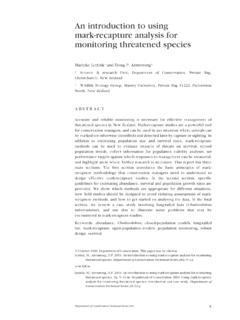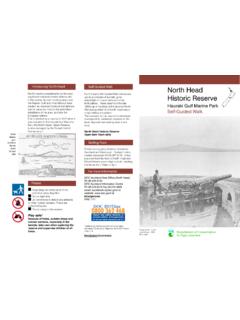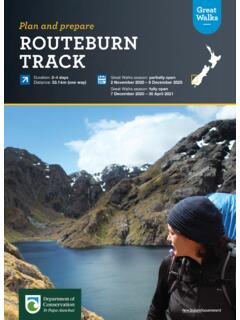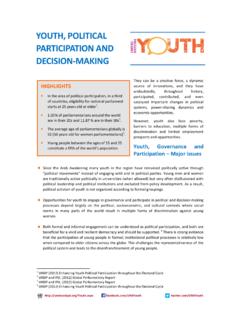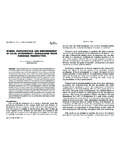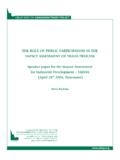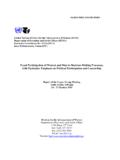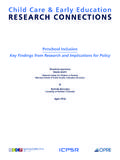Transcription of 2.3.2 Benefits and disadvantages of public …
1 17 Science for Conservation 308 Benefits and disadvantages of public participationPublic participation has many Benefits (PWCNT 2002; IAP2 2006); some are shown in Table 1. The main aim of public participation is to encourage the public to have meaningful input into the decision-making process. public participation thus provides the opportunity for communication between agencies making decisions and the public . This communication can be an early warning system for public concerns, a means through which accurate and timely information can be disseminated, and can contribute to sustainable decision-making (IAP2 2006).
2 These Benefits apply when public participation is a two-way process where both the agency and the public can learn and gain benefit (PWCNT 2002; IAP2 2006). Effective public participation allows the public s values to be identified and incorporated into decisions that ultimately affect them (Johnson 2001; PWCNT 2002; IAP2 2006).While there are numerous advantages associated with public participation in planning and decision-making processes, there are also disadvantages (MfE 1999; PWCNT 2002). public participation can be time-consuming and sometimes expensive.
3 To do it effectively, organisations have to build capacity and train staff. If done poorly, public participation processes can result in, for example, loss of faith in the agency. A negative experience of the process may lead participants to have negative perceptions of the outcome, and they may be less likely to participate in future 3. public participation Spectrum. Based on figure in IAP2 (2006: 35).Inform Consult Involve Collaborate Empower PublicparticipationgoalTo provide the public with balanced and objective information to assist it in understanding the problem, alternatives, opportunities obtain public feedback on analysis, alternatives, and/ordecisions.
4 To work directly with the public throughout the process to ensure that public concerns and aspirations are consistently understood andconsidered. To partner with the public in each aspect of the decision including the development of alternatives and the identification of the preferred solution. To place finaldecision-making in the hands of the public . Promiseto thepublicWe will keep you informed. We will keep you informed, listen to and acknowledge concerns and aspirations, and provide feedback on how public input influenced the decision.
5 We will work with you to ensure that your concerns and aspirations are directly reflected in the alternatives developed and provide feedback on how public input influenced the decision. We will look to you for advice and innovation in formulatingsolutions and incorporate your advice and recommendations into the decisions to the maximum extent possible. We will implement what you decide. Increasing level of public impact 18 Wouters et al. Evaluating public inputs in National Park Management Plan reviews Principles for public participationA number of authors have developed principles for public participation .
6 This section briefly describes these, from the general principles for public participation (should) to the specific principles (must) relevant to consultation in New Zealand and in IAP2 (2006) produced a set of core principles for the practice of public participation . These principles are:The public should have a say in decisions about actions that could affect its members livesPublic participation includes the promise that the public s contribution will influence the decisionPublic participation promotes sustainable decisions by recognising and communicating the needs and interests of all participants.
7 Including decision-making agenciesPublic participation seeks out and facilitates the involvement of those potentially affected by or interested in a decisionPublic participation seeks input from participants in designing how they participatePublic participation provides participants with the information they need to participate in a meaningful wayPublic participation communicates to participants how their input affected the decisionBest practice principles for public participation in protected area management, as shown in Table 2, formed part of the Benchmarking and Best Practice Program for the Committee on National Parks and Protected Area Management in the Northern Territory, Australia (PWCNT 2002).
8 Ronmark (2005) developed a suite of principles for measuring the process, outcome, and implementation of management planning processes in British Columbia s parks and protected areas. Ronmark considered that successful consultation should be fair, efficient, and informative. public participation Improved understanding of client expectations and user group needs Improved agency understanding of conservation issues Improved agency understanding of the role and contribution of the community Greater continuity in knowledge Ability to build community support for a project and to improve stakeholder relationships Improved public understanding of the agency s responsibilities Improved staff and community technical knowledge Improved agency credibility within the community Improved quality of
9 Decision-making by agencies Enhancement of social capital and flow-on social and economic Benefits Enhanced and informed political process Greater compliance through increased ownership of a solution Greater community advocacy for biodiversity protection Greater access to community skills and knowledge Improved community understanding of conservation issues and responsibility for conservation outcomesTABLE 1. Benefits OF public participation , FROM CNPPAM (2002).19 Science for Conservation 308should occur at an early stage, all interested and affected people should be represented, and public input should be used in the development and evaluation of alternatives.
10 Ronmark states that the process should involve shared decision-making. Stakeholders should be able to participate on an equal basis with administrative officials and technical similar lines to Ronmark (2005) above, Johnson (2001) considered principles for public involvement in environmental impact assessment (EIA) in New Zealand under the Resource Management Act 1991 (RMA). The key principles that this study considered to be imperative were:The public is involved early in the process The full spectrum of opinions and values is exposed Forums for participation are effective Issues of concern to the public are taken into account in reaching a decision The experience is positive.
